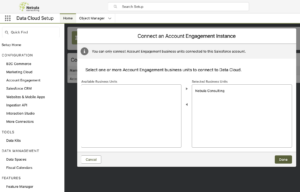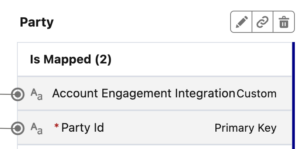Data Cloud is Salesforce’s answer to a customer data platform (CDP), tailored for easy connections between your Salesforce Org, Marketing Cloud, Tableau and much more. In this blog, we explore the connection between Data Cloud and Account Engagement (Pardot).
The importance of where Data Cloud lives
Data from your Account Engagement Business Units can be ingested to your Data Cloud account, if Data Cloud has been provisioned in your home org. If you have multiple Salesforce Orgs, or created a new Org to provision Data Cloud in, then Account Engagement data cannot be ingested to Data Cloud via the standard connector.

In this blog, we will assume that Data Cloud has been provisioned in your home org, connected to Account Engagement business unit(s).
Ingesting Account Engagement data
To ingest data from Account Engagement to Data Cloud, ensure that the business unit(s) is selected in the Data Cloud Setup:

This will create a Data Cloud Connector in Account Engagement, which can be paused and unpaused, similar to the Salesforce Connector. The data synced from this connector can be filtered, by selecting a date from which engagement data will be available in Data Cloud:

When unpaused, this will allow Account Engagement to appear in ‘Connected Sources’ when setting up a new Data Stream:

Currently, the only Data Bundle available for Account Engagement is for Email Engagement Data. We can select this bundle to create an Email activity Data Stream.
Looking for help with Account Engagement?
Using Account Engagement Data in Data Cloud
Once you are ingesting email engagement data, ensure you’ve also configured your Lead and Contact Data Streams to contain the Account Engagement fields that you’d like to use, as well as the Account Engagement Integration field. Learn more here.

Account Engagement data being present in Data Cloud now means that we can run powerful calculated insights and segmentation on our Unified Individuals.
Activate Segments in Data Cloud
Account Engagement acts as a not only a data source that we can ingest engagement data from, but also as a channel we can activate to. We can build our segments in Data Cloud and use these as our lists for emails and engagement studio programs. This allows us to build more advanced segments to ensure that we are delivering a truly connected customer experience.
For example, let’s say you want to nurture inactive customers with a medium-high Lifetime Value (LTV).
- First, build a Data Cloud segment which looks at customers who have a medium-high LTV, in the region that you would like to target, for the product/service that you would like to focus on.
- Next, publish your segment in Data Cloud.
- Create a dynamic list in Account Engagement, it is recommended to name this similar to your segment from step 1. Ensure for the dynamic list type, you select Data Cloud Segment.
- Use the dynamic list in your engagement program to nurture the prospects who match the segment criteria.
Lear more about Data Cloud Segments in Account Engagement Dynamic Lists here.
Something to consider, is that Data Cloud Segmentation is not currently included in your Account Engagement subscription, and isn’t available on the $0 Data Cloud. You can purchase additional Segmentation Credits for your Data Cloud subscription if you exceed your limit.
If you’re looking to take advantage of Data Cloud as a B2B business and need some support, get in touch.


